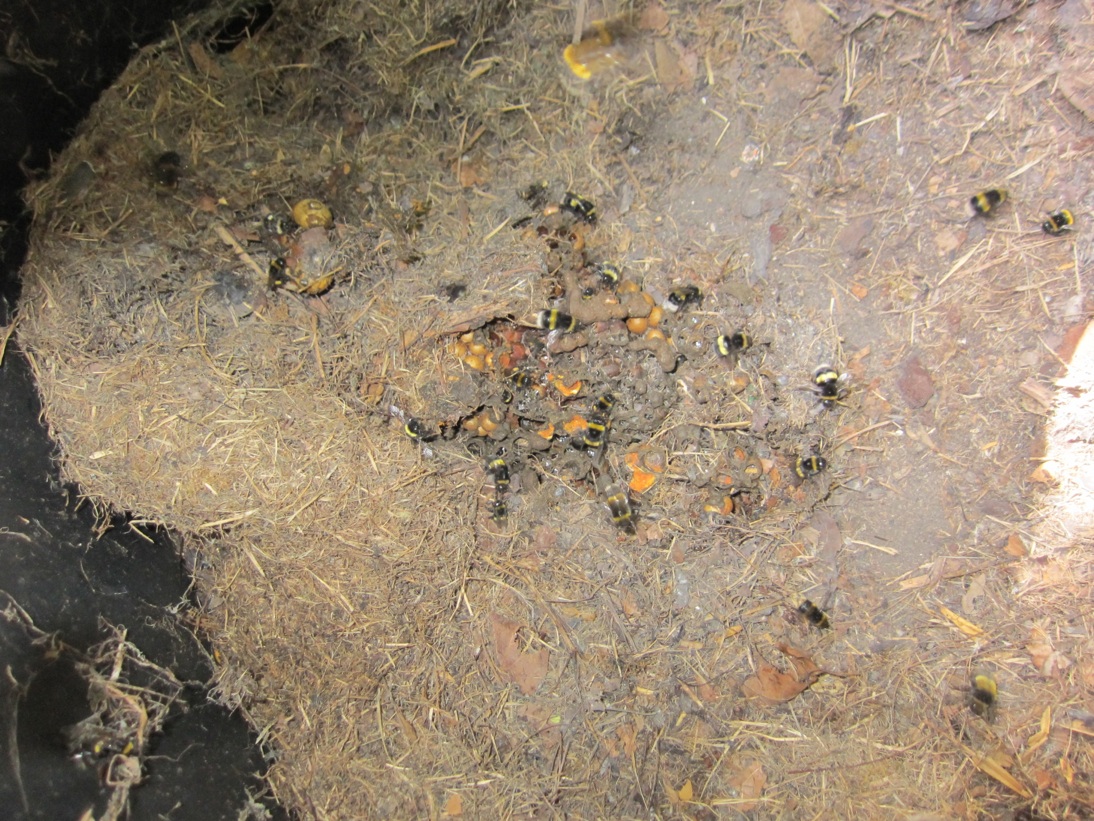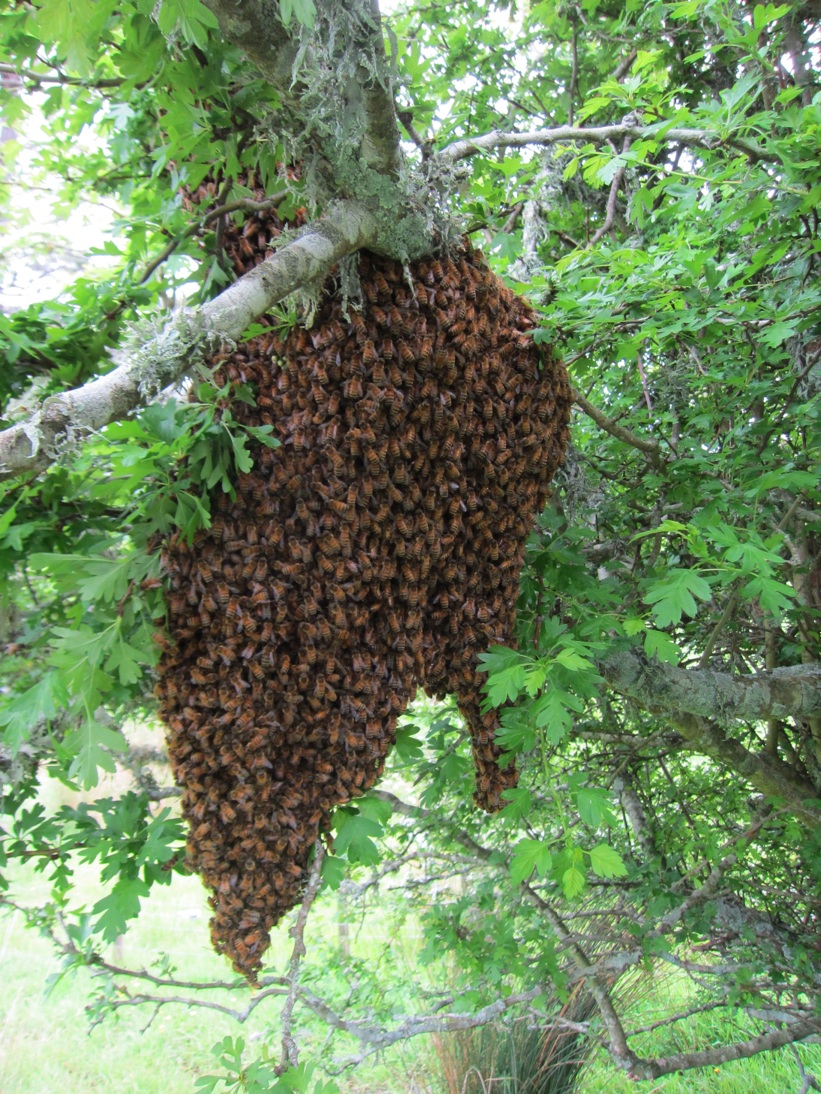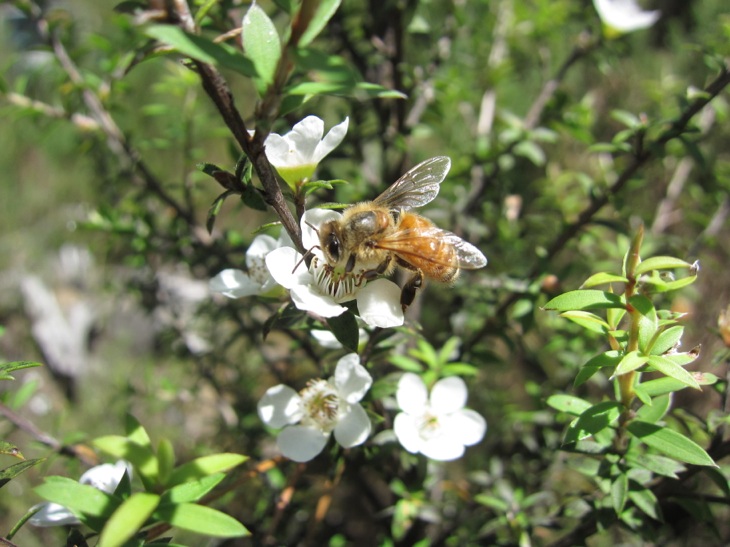BEES in New Zealand
BUMBLE BEES
Four species of bumblebee (Bombus) were introduced from England in 1885 and 1906 for pollination and seed production of red clover. Their longer tongues can reach inside red clover flowers, which the shorter-tongued honeybees cannot do - although they are excellent pollinators of the smaller white clover flowers. Bumblebees are sometimes used to pollinate greenhouse and orchard crops. They have become established and since varroa decimated the feral honey bees colonies their number have grown to fill the gaps left.
Queen bumble bees started flying early September looking for nest sites and most will have established their colonies. The queen finds an old mouse nest or a hole into the wall cavity or roof cavity of a house or shed, or into a wood pile or under a house in some rubbish –anywhere where it warm and sheltered.

She collects pollen and nectar, constructs a few wax cells and lays an egg in each. This first generation of female bumble bees are very small, about the size of your little finger’s nail. These young bees start flying after nest duties and support the queen by gather more nectar and pollen so the next generation is having more nutrition and therefore are about a third bigger. These in turn feed the next generation which are normal worker size bumble bees.
Worker bumble bees being female can also lay eggs but the queen’s pheromone suppresses their ovary development. When the nest is full size, here pheromone doesn’t reach all the worker bees so they begin to lay drone (unfertilised eggs that could turn into drone – male bees, but the queen eats them all while the nest is relatively small so only her eggs are raised as female ( worker) bumble bees. Only when the nest expands to about 50 bees or more with worker bees laying eggs is she is unable to eat them all at which point the nest starts developing drones. Mean while the queens is also laying drone eggs and eggs into larger cups that turn in queens.
When these start to develop, the workers kill the queen which ends brood rearing so that the nest ends up with workers, virgin queens and drones. The new virgin queens and drones mature, mate in the open and the new queens go off looking for a new nest site to establish there own nests or if its autumn, the queens will looks for a winter hibernation site. Meantime the colony collapse, mites take over feeding on the scraps of food and comb that remain and the nest is abandoned.
Bumble bees are the best pollinators for your garden as they are generalists and will visit every flower.
Honey bees on the other hand will search out the best nectar and pollen source for the least energy consumed so will often ignore you plum, pear and peach trees in full blossom.
Like honey bees, the bumble bee remembers the location of its nest site. Where they are in the wrong place; a compost bin, in a wall, under a deck by the front or back door etc., they do become a little disconcerting to humans with their comings and going as they only see them as stinging insects. Some parent fear that their children will be stung, but generally if you leave them alone, they will leave you alone.
Despite this, some residents want rid of them and ask beekeepers to remove them. Unfortunately any nest disturbance upsets the harmony of the colony and the queen will abandon the hive so if in the way, its best to destroy them.
This can be undertaken by a registered pest exterminator or you can try this yourself. Pour about a tablespoon of insecticide (from a garden centre) into the hole but the ground must be dry otherwise the powder will not be taken into the nest. Under a house or in the ceiling is a different matter at the nest site can be metres away from the entrance where they are going in. You can also use a borer bomb in the ceiling of the house to kill the bees but its best to advise the fire brigade first as you don’t want fire engines turning up unexpectedly.
An alternative is to tip a bucket of soapy water down the hole but this will only work if there is a holes going downwards.
In most circumstances, by the time you discover a bumble bee nest its half way through its life cycle and it will die out within a couple of months on its own if left alone. This is much the preferred way of dealing with bumble bees.
There are very good videos on the net: http://www.bbc.co.uk/nature/life/Bumblebee#p003xjcr
Wasps
There are two types of introduced vespulid wasp in New Zealand. Vespular Germanica came into Hamilton after the Second World War in aeroplane cases and the other, Vespular Valguras, the common wasp came into New Zealand in the 1970’s
Around about Christmas gardeners start noticing wasps flying about and usually discover a nest when they disturb the ground while weeding - and these little creatures with defend their nest in numbers and their stings can really hurt.
A beekeeper gains immunity over time to bee stings and will be over the pain of a bee sting in a minute or two but wasps have a different poison make-up and having only a few barbs on their sting, will sting a number of times before being slapped away and these will remain sore and itchy for a week.
Generally the treatments for a wasp sting is wash the area, put ice on it to reduce the spread and pain and perhaps see a chemist and get some anti-histamine.

Wasp nests start off similar to bumble bee nests with a single queen. A queen overwinter in a hibernation state and when the weather warms she will begin looking for a nesting site in a hole in a bank or under a pampas bush or in or under a house. Queen wasps will fly up to 40 kl so can really move around looking for a suitable nest site.
Wasps feed on insects - flies, spiders, caterpillars, aphids, etc., so are very useful in the environment but in great numbers, such as in our national parks where there is honey dew, they can cause real problems to the bird life.
In the suburban garden, they are OK until the build up and become a nuisance. The normal nest in a hole in a bank (along stream beds on farm land). A hole created by an old tree root and once established will dig out the chamber further removing the dirt and bring back strips of decaying wood which the chew and make a paper mashie covering that insulates the nest.
Finding the nest is essential when wasps become a nuisance. On farm land finding them can be a problem as there are so many placing they can be, but thy fly later in the evening than bees and as the sun get low in the sky you can see the sun reflect off their winds as the fly directly back to the nest.
They can be killed the same way as bumble bees; insecticide powder down the hole or a large coke bottle full of diesel pushed directly into the hole to block it and the fuel will fumigate the nest.
There’s a trick to approaching a wasp nest. They can feel the vibrations in the ground and will be out in an instant to defend the nest if disturbed, so you must approach the nest from the side on and “tip toe” towards it. Sometimes it is easier to kill a wasp nest at night but don’t hold a torch as they will fly at the beam and get you. Invite somebody else to hold the torch.
The other important thing to do is that as soon as your administer the poison, quickly get out of there!
Things can go wrong, so when I kill a wasp nest, I generally wear a bee suit with jeans and the thick jersey underneath as their sting will go through a normal bee suit.
Don’t do anything stupid and if unsure of what you are doing, perhaps its best to leave such things to the professionals.
OTHER WASPS
New Zealand over the last twenty years or so has had several different wasps species get through our biosecurity net. Paper wasps make a small hanging nest in tree or under the eves of a house. A bit of fly spray into the nest at night will generally dispatch them when they become a nuisance.
HONEY BEES
From October to December honey bees build up numbers and when the reach about 40,000 bees in a hive (25,000 look after the brood in the hives – the rest are flying bring in nectar and pollen and water.), they get crowded and make preparation to swarm. If the beekeeper is on top of things he/she will give the bees more room or split the hive creating a division but despite the beekeepers best efforts, some hives will swarm.

On a nice warm still day (after the bees have made queen cells to replace the old queen) half the bees in the hive will take to the air in a big circling mass. The buzz is quite loud. Birds will stop singing and generally people take cover although they don’t really need to as they are just passing through to a new hive site - a hole in a house or shed, or in a tree.
While the bees are in the air nothing can be done. The swarm has to settle before it can be taken away. Hopefully on a tree branch that is within easy reach of the ground. Most beekeepers will pick up a swarm for a small fee to cover expenses and some will do it for nothing.
The beekeepers shakes the mass into a box waits for most to go in and then has to quickly seal it up as the bees quickly accept the box as home and will begin flying again collecting pollen and nectar.
Unfortunately he can’t take all the bees away as scouts will be out looking for a new hive site unless the box is left until dark when they will have all settled for the night.

Generally if taken straight away, a few hundred bees will gather in the same position where the swarm was and being lost, will stay there. Best to kill them with several sprays of fly spray or cover them with a half bucket of soapy water (after dark is best).
Generally while the bees are in the swarming mode, they are not defending their hive so will not attack people. Under a beekeeper’s supervision, you could gently push your hand into a swarm and feel how warn it is but if the swarm has been on a branch for a day or two because of bad weather, they will have use the nectar stored in their bodies as food and will then be a little bit more tetchy and when handled – they will sting!
If you are brave enough and the swarm is low to the ground, place a cardboard box directly underneath it and give the branch a sharp pull. The majority of the bees will fall into the box. Flip three of the four flaps to partially cover the box and the bees will quickly relocate into the box, (those outside will walk in if the queen is in the box) ready for the beekeeper to pick up.
Councils and hobbyist clubs have list of beekeepers willing to pick up swarms.
NATIVE BEES

When you see manuka flowering, our native bees will start emerging from tiny holes in banks or in sandy ground. These are black and are generally much smaller that a honey bee and are fairly harmless. They have a tiny sting that’s just like a pin prick but being solitary they tend not to sting.
There are 28 species of native bees plus another 13 introduced species in New Zealand. (Four of these are bumblebees - above) The native bees vary in size from the size of a sand fly up to the size of a normal worker bee and are an important part of our eco system so protect nest sites if you have them on your land.
Every pollinator is precious and we depend upon them for the majority of what we eat.
Website: www.landcareresearch.co.nz
Extract from the website on Apoidea - A total of 41 species of bees are known from the greater New Zealand biogeographical area of which 27 are endemic, that is found only in New Zealand, and of these, 14 are new to science. Another five species are also present in Australia and clearly have originated from there, one other species is European in origin, and eight species have been purposely imported from the Northern Hemisphere.
October 2012